Editor’s Note: This story focusing on El Salvador is the fourth in the World-At-Home series, in which we attempt to “travel” around the world without ever leaving San Diego County .
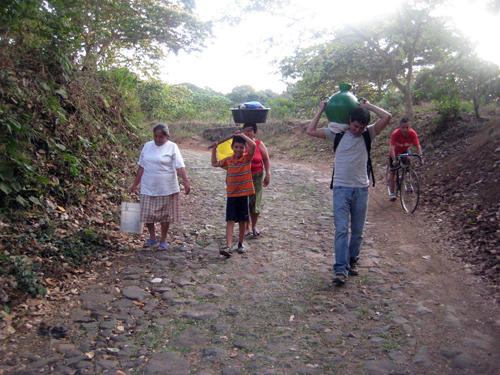
By Donald H. Harrison

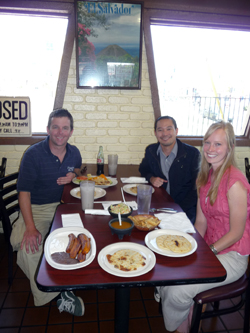
SAN DIEGO –Tim Boelke and Eugene Kaneko, respectively the founding and current presidents of the local chapter of Engineers Without Borders, scanned the menu at El Salvador Restaurante y Pupuseria, and inquired of Emily Legault exactly what a “puposa” is.
Legault recently participated in a site vist for a proposed water project in the small village of La Chiripa, El Salvador. She responded that the popular Salvadorean food is made from a tortilla that is thicker than the kind used in Mexico for burritos. It has almost the consistency of Middle Eastern pita. Puposas, she noted, can be stuffed with any variety of contents, whether meat or vegetables.
Maybe, suggested one of the men, the San Diego Professional Chapter of Engineers Without Borders (EWB) could have one of its meeting at the restaurant, located at 3824 University Avenue. The others agreed that might be a good idea, especially to give a little of the flavor of El Salvador to members of the support team who remain in San Diego.
La Chiripa is a village of 24 households, containing approximately 100 people. Its name meaning “The Fluke,” suggest its settlers were aware that the village grew more by happenstance than as a result of planning. Its residents are laborers who work at nearby coffee farms, and the families of these laborers. The village has electricity, and television, but no fresh water.
Residents hike either a kilometer uphill or a kilometer downhill to obtain the water. At the top of the hill close to the village of Marquezado is a spring, which attracts the residents of several other villages. At the bottom of the hill in Santiago de Maria is a municipal water facility, which sells its water. Women often transport the water in either direction in a 5-gallon jug called a cantarada that they balance on their heads. Pairs of children often carry the cantarada between them. What source they choose for the water often depends on whether they live at the top of the hillside town or at the bottom.
The men help in the water hauling when they can, said Legault, but during the day they are away at work at the coffee plantations.
The San Diego EWB Chapter has agreed to construct a potable water system for La Chiripa, located about two hours east of the capital of San Salvador on Highway 1E, which is part of the famed Pan American Highway. From Santiago de Maria visitors can reach La Chiripa by driving up a “really, really rough cobblestone and dirt road,” said Legault. “You only go a mile, but it takes 20 to 30 minutes because it is so bumpy.”
Boelke, who founded the EWB’s San Diego Professional chapter in 2005, said that an American named Dennis Johnson, who is now married to La Chiripa resident Eneida Molina, told an EWB member about the village’s need for water, and that member in turn brought the situation to the attention of the chapter. Boelke said the chapter became immediately interested in doing the project because of the satisfaction it offered in making a real difference in people’s lives.
Employed by a private engineering company, Boelke says in the U.S. he and fellow engineers do projects that make clients’ lives a little bit better, whereas the La Chiripa project “allows us to use our skill sets for people whose lives will be drastically improved—from not having a source of water, to having one.”
Likewise, the chapter is engaged in projects to de-salt a fresh water source in Andhra Pradesh, India, that was infiltrated by sea water, and to provide electricity, both from the grid and from solar panels, to a learning center in Mbita, Kenya.
Boelke said he was attracted to the concept of Engineers Without Borders, (which was modeled after Doctors Without Borders) because it can help people “who will be forever grateful for a drastic life improvement” providing engineers “satisfaction that we can’t get anywhere else.”
At first, said Boelke, Engineers Without Borders thought that providing La Chiripa with water would be a fairly straightforward engineering project, involving pumping the water up from the municipal waterworks to the village. But the municipal water authority vetoed the idea, explaining that there was not sufficient water to provide both Santiago de Maria and La Chiripa on a continuous basis. Given that water usage would likely increase dramatically if villagers simply had to turn on a tap, the municipal water authority possibly may have been correct in its assessment.
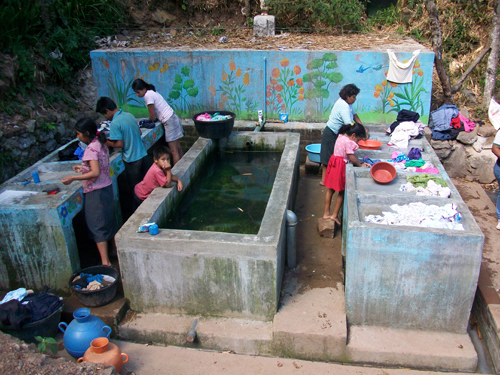
Taking the water from the uphill spring was not really an alternative, Boelke said, because so many other villages depend on that source. And besides that, the spring is located on private farm property, so La Chiripa had no legal rights to the spring. Furthermore, the EWB team members tested the spring water, in which some villagers wash their clothes, and found that it contains disease-causing bacteria.
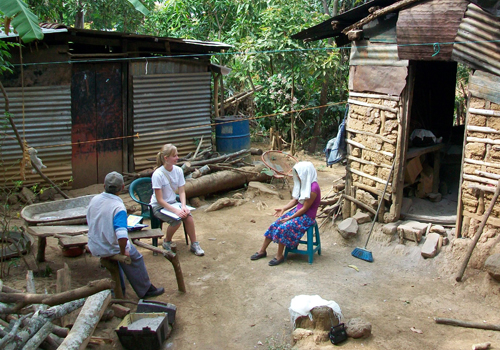
This past March, Legault and fellow team members Patrick Howell, Victor Tsai, and Arturo Garcia spent six days in La Chiripa and another four days in other parts of El Salvador studying alternative plans and identifying possible sources of financing and cooperation. During the six days in La Chiripa, the volunteers stayed in pairs for one night at successive villagers’ homes, enabling them to get to know many of the village families on a more personal basis.
They also met more formally with residents of each household to talk about the project and to “listen to feedback, concerns, input and ideas, collect health data on the most prevalent illnesses, and just chat with residents and get to know each other,” Legault said.
Team members tested water at each household “for E coli, total coliform, nitrate, nitrite, copper, chromium, arsenic, total and free chlorine, ammonia, phosphate, alkalinity, total dissolved solids, conductivity pH and hardness,” she said.
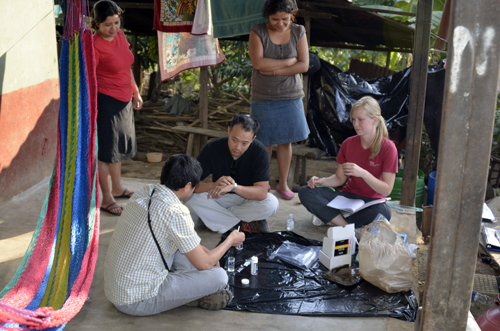
Legault, who was graduated from the University of Texas and who will be taking graduate studies next term at the University of Washington, said that she enjoyed playing with the children of La Chiripa in her off hours, adding that she was a source of wonderment to many of the women of her village.
In that Legault is married to a Navy officer stationed aboard the USS Milius, the village women had difficulty believing that, at her advanced age, she and her husband still did not already have children. “By the time women there reach my age, they have two,” said Legault. “I’m 25,” she added.
I slapped my palms to my cheeks in mock shock, exclaiming “That old!”
Although we all laughed, the truth is that what seems young here in the United States may indeed appear old for child-rearing elsewhere. Legault has been busy volunteering, having spent time in Panama on another water project, and having served as an AmeriCorps volunteer here in San Diego.
Wherever in La Chiripa the assessment team members stayed, the village women insisted on cooking more and more meals for them, Legault noted. Although they were grateful for the tasty food, one thing that the visiting Americans noticed was that the cheaply-constructed houses in La Chiripa did not have proper ventilation, resulting in their interiors becoming saturated with smoke — really an unhealthy environment.
In such situations, EWB members have learned to resist the temptation to say something like, “well, yes, your water project is important, but what might be even more important would be a project to ventilate your homes so your children don’t have to constantly breathe smoke.”
Part of the ethics of the organization is not to impose priorities on project communities, but rather to be guided by the villagers’ own wishes, Boelke said. And right now, the villagers of La Chiripa are focused on having a source of water.
Legault said it was initially estimated that it would cost approximately $65,000 to build a system for pumping water uphill from the municipal water works. This estimate calculated the cost of materials as well as team members’ roundtrip transportation from the United States to the project site. It also projected some in-kind contributions from local companies.
Now, an alternative project to catch, purify, and distribute rainwater in La Chiripa is under consideration and such a solution is likely to reduce the overall cost of a water project by almost half. While the rainwater, in itself, is pure, it typically lands on rooftops that may be dirty, and is then funneled into vats and should be subjected to filtration, perhaps by reverse osmosis. Legault said the community still is debating whether common reservoirs should be built, or whether each house should be equipped with its own system for catching the rainwater.
While La Chiripa does not have an official village council, by consensus two women have been appointed to serve as the village’s liaisons with the American engineers. One is Eneida Molina de Johnson, the wife of the American; and the other is Sonia Batres.
“We communicate with Sonia every two weeks, telling her how the design is coming and whatever we need to communicate to the community,” Legault said. “She will call the people together and communicate the information. And before we go to Salvador, Sonia and Eneida organize a lot of meetings for us, with the water authorities, with some of the local NGOs (non-governmental organizations) and they attend these meetings as representatives of the community.”
Kaneko, the chapter’s current president, said that like some other chapter members involved with the project in La Chiripa, he has not visited El Salvador, but has been active in such tasks as raising funds and administering other details.
“Projects need engineers who are motivated and happy,” he noted, “but if you run out of money you can’t get to the next step.”
The San Diego chapter holds “Thirsty Thursday” parties at local cantinas that donate a percentage of the proceeds back to the non-profit organization to be utilized for its various projects. Additionally, EWB solicits local engineering firms, other businesses, and foundations for financial assistance for its projects.
When Engineers Without Borders agrees to work with a community, typically it does not simply build a project and then cut and run. Instead, noted Legault, EWB makes a five-year commitment to that community, sometimes following up one project with another.
So, if the people of La Chiripa decide after assuring their water source that they also would like to do something about the cooking smoke in their houses, that may be a project that the San Diego Professional chapter will tackle.
Boelke noted that while engineering may be at the core of many of these projects, volunteers from other specialties are always welcome. For example, the project in La Chiripa might benefit from public health officials, community organizers, sociologists and experts in cross-cultural relationships.
To volunteer, or to contribute, or to learn more information, one may contact Boelke at timothy.boelke@shawgrp.com
*
Harrison is editor of San Diego Jewish World. He may be contacted at donald.harrison@sdjewishworld.com
Pingback: Autóalkatrész Miskolc